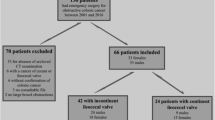Abstract
Aim
The aim of the study was to perform histomorphologic, endoscopic, and radiologic studies of the ileocecal junction (ICJ). A clearer understanding of the anatomical structure of the ICJ may shed some light on its function.
Methods
Histomorphologic studies were performed in 18 cadavers and radiologic in 22 and endoscopic in 10 healthy volunteers. Morphologic studies were done with the help of a magnifying loupe: histologic sections were stained with hematoxylin and eosin and Masson’s trichrome. The ICJ was studied radiologically using the method of small bowel meal. Endoscopic study was done under controlled air inflation using a video endoscope.
Results
A nipple (1.5–2 cm long) with transversely lying stoma protruded from the medial wall of the cecum. A fornix was found on each side. The nipple stoma was surrounded by two lips: upper and lower. A mucosal fold started at both angles of the stoma and extended along the cecal circumference. It was marked on the outer cecal aspect by a groove.
Conclusion
The ileocecal nipple is a muscular tube with a transversely lying stoma and is suspended to the cecal wall by a “suspensory ligament”. The morphologic structure of the ileocecal nipple was confirmed endoscopically and radiologically. The ileocecal nipple was closed at rest and opened upon terminal ileal contraction to deliver ileal contents to the cecum. It evacuated the barium periodically into the cecum. The ileocecal nipple structure seems to be adapted to serve the function of cecoileal antireflux.












Similar content being viewed by others
Abbreviations
- ICJ:
-
Ileocecal junction
- ICN:
-
Ileocecal nipple
- IC:
-
Ileocecal
- SD:
-
Standard deviation
References
Boggers JJ, Van Mark E (1993) The ileocecal junction. Histol Histopathol 8:561–566
Calabuig R, Weems WA, Moody FG (1996) Ileo-cecal junction: a valve or a sphincter? An experimental study in the opossum. Rev Esp Enfer Dig 88:828–839
Flourie B, Phillips S, Azpiroz F (1989) Cyclic motility in canine colon: responses to feeding and perfusion. Dig Dis Sci 34:1185–1192
Gorbach SL, Plant AG, Nahas L, Weinstein L, Spanknebel G, Levitan R (1967) Studies of intestinal microflora. II. Microorganisms of the small intestine and their relationship to oral and fecal flora. Gastroenterology 53:856–867
Hoffmann R, Gomez R, Tanagho EA (1993) Motility and intraluminal pressure of the ileocolonic junctional zone and adjacent bowel in a canine model. Urol Res 21:329–332
Kajimoto T, Dinning PG, Gibb DB, de Carle DJ, Cook IJ (2000) Neurogenic pathways mediating ascending and descending reflexes at the porcine ileocolonic junction. Neurogastroenterol Motil 12:125–134
Kellogg VL (1913) Ecto-parasites of the monkeys, apes and man. Science 24:601–602
Mizhorkova Z, Kortezova N, Bredy-Dobreva G (1994) Role of nitric oxide in mediating non-adrenergic non-cholinergic relaxation of the cat ileocecal sphincter. Eur J Pharmacol 265:77–82
Phillips SF, Giller J (1973) The contribution of the colon to electrolyte and water conservation in man. J Lab Clin Med 81:733–746
Quigley EM (1988) Motor activity of the distal ileum, ileocecal sphincter and its relation to the region’s function. Dig Dis 6:229–241
Quigley EMM, Phillips SF, Cranley B, Taylor BM (1985) Tone of canine ileocolonic junction: topography and response to phasic contractions. Am J Physiol 249:G350–G357
Quigley EM, Phillips SF, Dent J, Taylor BM (1983) Myoelectric activity and intraluminal pressure of the canine ileocolonic sphincter. Gastroenterology 85:1054–1062
Sarna SK (1991) Physiology and pathophysiology of colonic motor activity. Dig Dis Sci 36:998–1018
Snell RS (1995) The abdominal cavity. In: Snell RS (ed) Clinical anatomy for medical studies, 5th edn. Little, Brown & Co., Boston, pp 183–244
Sutton D (1990) The small bowel. In: Sutton D (ed) A textbook of radiology and imaging, 4th edn. Churchill Livingstone, Edinburgh, pp 863–903
Ulin AW, Deutsch J (1950) Visualization of ileocecal papilla in a living subject. Gastroenterology 16(2):444–449
Acknowledgment
Margot Yehia assisted in preparing the manuscript.
Conflict of interest
The authors declare that they have no conflict of interest.
Author information
Authors and Affiliations
Corresponding author
Rights and permissions
About this article
Cite this article
Shafik, A.A., Ahmed, I.A., Shafik, A. et al. Ileocecal junction: anatomic, histologic, radiologic and endoscopic studies with special reference to its antireflux mechanism. Surg Radiol Anat 33, 249–256 (2011). https://doi.org/10.1007/s00276-010-0762-x
Received:
Accepted:
Published:
Issue Date:
DOI: https://doi.org/10.1007/s00276-010-0762-x




